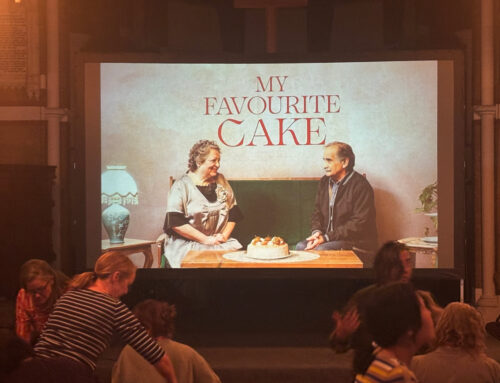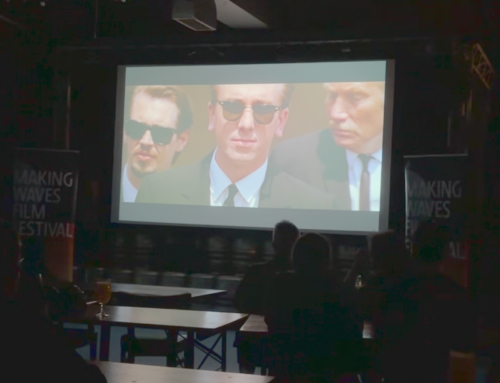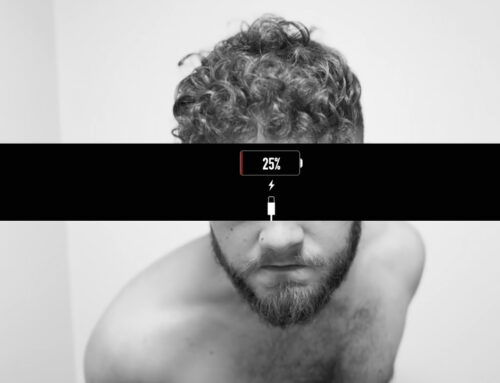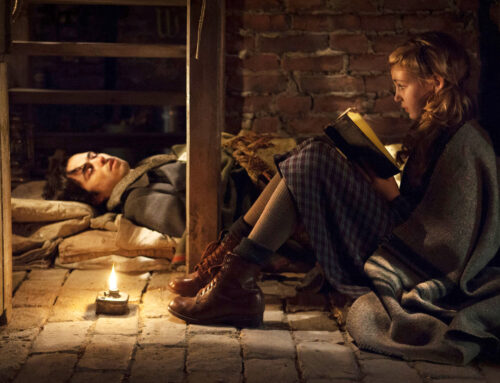The eye is drawn to the bar, decorated with a small grid of vintage film posters, surrounded by fairy lights which enwrapped various pipes across the ceiling, which if you looked at it for long enough convinced you that you were in fact in some kind of cruise ship, a beacon of socialising, colour and light.
Everything about the event made me feel like I was immersed in the movie. A romantic feel achieved by delicate flowers in vases on round tables dotted across a café set up brings the genre of the movie to life in the venue. Filming crew set up in the corner, felt like we were a part of a very special moment, lucky to hear the behind-the-scenes secrets.
The Q&A was incredibly informal and intimate. Casual wear as far as the eye could see and questions read of off a phone in a hesitant voice over a handheld mic. Nevertheless, we all watched intently. The truth of it is it was the relaxed, enjoyable experience which allowed everyone to feel comfortable and for the stories to flow effortlessly from our esteemed guest. Moments of laughter but also incredibly interesting and profound insight into the industry.
People leaned forward in their chairs or lined the walkway to the café area where the events were unfurling. It was truly surreal and rather joy inducing to see everyone’s eyes focusing on the same spot, all hanging on Harry’s every word. Amongst the clear silence that comes from absolute attention, I hear laughter and the rising noise of positivity as the audience hears an anecdote or two or a particularly impressive question from a fellow member of the crowd.
This film has been described as enveloped in music, humour and emotion and that is exactly what this event was. As the interviewer said, it was a room full of film nerds enthusiastic about the chance to fully understand the process of audio from sound that almost miss the ears of an unexpecting audience but are felt by the heart and soul to contributions to the soundtrack and diegetic music. Escott offered some insight into where he started and how he found and developed his craft, highlighting the importance of making connections and working through things naturally.
Particular focus was given to scenes to look out for with tunes gifted by an actor’s ukulele and a character’s mixtape as well as highlighting a cover of ‘Grace’ which can be found in the credits, a song which holds a special position of encapsulating a whole history of the character Ava and her relationships with other characters, and the story behind that particular recording. Sure enough, people stayed seated in the audience as the beautiful melody and vocals played and the credits rolled. There was not an audience member present that could have left that event saying that the choices of audio and song in film mean nothing.
I had the pleasure of witnessing networking in action as people brought together by this event set potential plans for the future. I watched a smile spreading across someone’s face at the realisation that their work had been seen and appreciated by someone, in the industry that inspires them and could keep them talking for years, left holding a card in surprised shock as they walked away.
The film was casual, funny, and endearing. Layering of sound is immediately noticeable, creating this key notion of harmony. The visuals demonstrated some interesting experimentation with close-up shots and aperture which were able to demonstrate how these emotional moments feel for characters who keep their struggles close to their chests.
It’s that situation where from the outside you may not know that someone is struggling but we are forced to look at details, almost slip into their perspective, climb inside their brain. Ali and Ava can see these subtle tells in each other as it is something they both do themselves. With a simple “something’s on your mind isn’t it” they see these similarities and force each other to see things in themselves
As much as this story focuses on a romantic connection, it finds rightful space for heartbreak and the act of letting go. The characters of Ali and Ava are both helpers, the kind of people who go above and beyond to make others lives easier, and it only emphasises how little time they take for themselves.
Demonstration of their connection through music is frequent. Loud songs never lasted long before they cut off and new scene began, an amazingly effective demonstration of these characters tendencies to avoid focusing on themselves and lying in their own tensions and negative emotions.
We also see this beautiful emotional connection between Ali and Ava develop in relation to a young girl. She brings them together at the start and mirrors their struggles in body language and emotion throughout, linked together by the music, until it comes full circle and she overcomes her fears.
A particular moment of laughter is a scene where Ali and Ava pick up some kids causing some chaos on the side of the street. It’s the first moment of many where we see that the character of Ali has this special ability to defuse tension in seconds, a superpower that is welcomed in many moments amongst this narrative.
As a secret is revealed, Clio Barnard tackles the key theme of change and we see our first notion of a stream of genuine struggle through issues of separation, divorce, drinking and abuse. The tone of the film takes a turn and we see Ali and Ava explore deeper, more meaningful, similarities, made endearing by a natural humour between them as these characters of an older age begin to act like kids in love.
Music dictates mood even when what we see in a scene seems happy. The audience go through a rollercoaster of emotions: We sit in moments of silence, feeling sadness and melancholy, and a deep drone creeps in building the tension until it becomes overwhelming, in a moment of pure heartbreak, we catch Ali feeling the absence of a child, perspective seems to take a positive turn as we have a moment of just Ava and the music through her earphones, incredibly effective subtle signs of danger or upset bring us to the edge of our seats, a moment of relief comes when troubles literally fade from focus when they look at each other.
Ava tells a personal story as the frame goes out of focus and the camera seems to pan. There is almost an expectation that the shot will land on something or someone that the audience is able to focus on but in truth, this would take away from the content of the story. Instead, our eyes dart across the screen of spreading colours amongst exhibits of bokeh and light but we are taking in every word she says. The outside world doesn’t matter in this moment, it just disappears.
By Louisa Clarke






